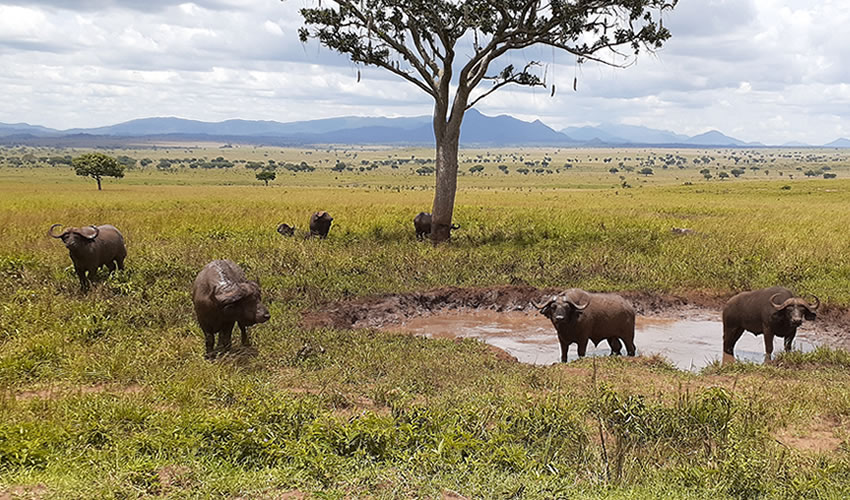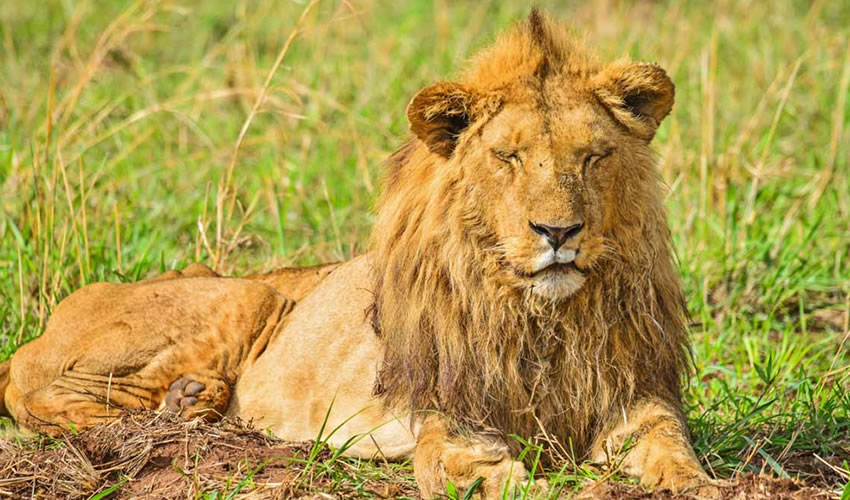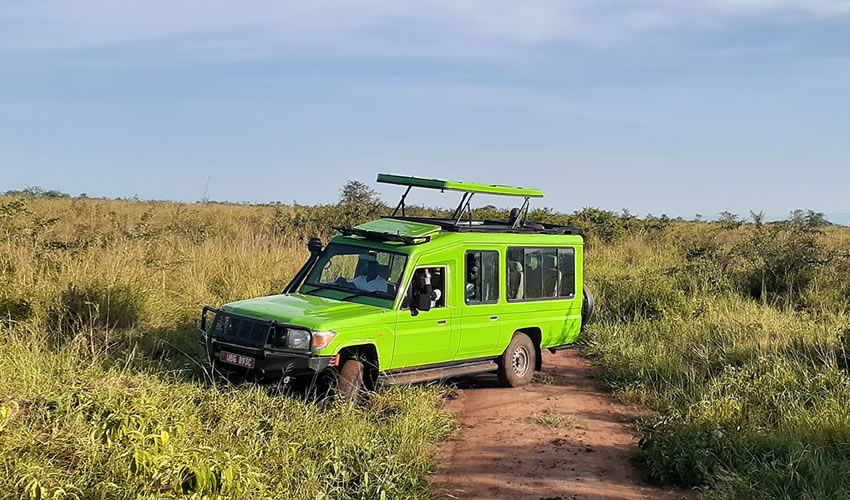Kidepo Valley National Park is located in the far end of northeastern Uganda creating borders with south Sudan and Kenya. It is situated near Karenga in Kaabong district and it costs 250km from Moroto town in its northwestern direction. Moroto is the largest and the main town in Karamoja region. It also takes 560km from Kampala, the Uganda’s Capital city to reach Kidepo Valley National Park by road and we recommend the use of a 4×4 Extended Safari Land cruiser.

Kidepo Valley National Park covers an area of 1,442km2 and it is being dominated by the 2,750m of Mountain Morungole, partly rugged savannah and also transversed by the Kidepo and Narus rivers. The park hosts 77 mammal species and 475 bird species and it is the second highest next to Queen Elizabeth National Park with over 600 bird species. The mammal species in Kidepo include Elephant, Common Zebra, Buffalo, Spotted Hyena, Leopard and Lion are frequently seen, Bat-eared Fox, Carcal, Cheetah, Klipspringer, Striped Hyena, Lesser Kudu, Grant’s gazelle, Bohor Reedbuck, Waterbuck and Kongoni, Oribis, Guenther’s Dik Dik. Senegal Galago and Side striped Jackal, White-tailed Mongoose among other species and they can all be seen in your Uganda Safari to Kidepo Valley National Park.
Kidepo Valley National Park is Uganda’s most isolated national park and one of the most spectacular parks with scenery unlike any other in East Africa and it offers a beautiful Vista of the breathtaking Savannah and mountain Landscapes which end in a rugged horizon. The few who make the long journey north through the Karamoja region will agree that Kidepo is the most beautiful and magnificent National Park and it ranks among Africa’s finest wildernesses. Uganda Safaris to Kidepo Valley National Park provide opportunities of remarkable wildlife encounters during game drives through the park.

A huge latitudinal range, correspondingly wide climatic conditions have evolved an extremely diverse flora. As a result, the variety of animal species in the park are equally diverse including many of which are found nowhere else in Uganda. Kidepo Valley National Park harbors lions, Zebras and Giraffes are a sight to admire in this area.
The Kanangarok Hot springs that cross the Kidepo River are also worth a visit. They are 40 Km away from Apoka camp. They are locally known as Maji Moto. Chances of seeing the Zebras, elephants, giraffe, cheetah, lions, ostrich and the Kudus in this area are high. Kanangarok Hot springs which mean place of black stones in the native language are a small collection of natural hot springs located near the Sudan border in Kidepo National Park.
On the way to the Hotsprings, our tourists are amazed by the way we cut through two main biomes of Kidepo; Savannah grasslands in the Narus Valley then to semi-arid short grass area in the Kidepo Valley National Park.
The natives neighboring the park have a rich diverse culture which consists of traditional dances, handicrafts, spears and hand bungles from beads among others.
The Ik are one of the most reclusive tribes in Uganda and still live in a very high traditional manner. They live on top of the Morungole Mountain in seclusion.
A visit to the Ik tribes takes about 12-hour round which includes hikes. They are hospitable and prior bookings to visit them are made.
The Ketebo people who currently live in Torit in south sudan also known as the Mening people while in Uganda are the inhabitants’ farmers and hunters of Kidepo Valley National Park and they lived in this area since 1800. The Katebo people are the sub tribe of Lango people in Uganda who are mostly referred to as the “Bira” people by the Europeans and also the Didinga call them the “Loceha/Loceka”. In 1958, it was made as the game reserves by the British administration so that to protect the animals from being hunted and further clearing of the bush in order to control the tsetse flies. The process evicted the residents who migrated to other areas like the Katebo people relocated to places of Bira like Napotpot, Kalo Kudo, Namosingo, Loriwo and Naurkori in South Sudan.
In 1962, the reserve was upgraded into a national park hence Kidepo Valley National Park by the newly independent government of Milton Obote. The first warden of park was Ian Ross and in 1972, Paul Ssali took over and replaces him as a warden. Their handover and training was the subject of the 1974 American documentary film, “The Wild and the Brave”
MAIN TOURISM ACTIVITIES AT KIDEPO VALLEY NATIONAL PARK
-
Game Drives in Kidepo Valley National Park

The early morning game drives start at 6:00 am; evening at around 4:00pm depending on how you have organized with the guide and lastly the night game drives start at 7:00pm. Early morning game drives makes visitors catch the sun rise behind the mountain before flooding the valley then off for the whole day game drive to the ostrich farm and it is not any man made occurrence, but given the massive number of the birds one would compare it to this along, then we shall be able to view herds of elephants, cape buffalos, giraffes, lions, Cheetah, Leopards, Hyenas waterbucks, bat-eared fox, Bohor reedbuck, Oribi , aardwolf, dikdik, caracal and then the hot springs at kanangorok.
The game drives are commonly done at Narus valley and Kidepo valley. So at Narus valley, wildlife is most active very early in the morning (6:00am) and evening times (4:00pm). Kidepo Valley is short on big game but massive on scenery and the drive to Kanangorok Hot Springs passes some magnificent landscapes. African Pearl Safaris recommends a 4×4 wheel drive Safari Land cruiser.
The Park is a completely different world of vast plains, in spring view from every vantage point, with a lot of wildlife as you drive into the park. Kidepo offers breathtaking open savannah which is surrounded by spectacular mountain landscape nowhere to be seen in Africa! Kidepo Valley National Park is Uganda’s second biggest National Park and one of the Africa’s finest wilderness areas.
-
Bird Watching at Kidepo Valley National Park
Bird watching is one of the interesting activities to take on while at Kidepo Valley National Park. Apoka Rest Camp also known as UWA bandas is point where visitors to Kidepo can start their bird watching activity. Later, you can extend it to fringes of the Narus valley and Namamukweny Valleys. On your birding safari here expect to see species like Abyssinian Roller, Purple Heron, Abyssinian Ground Hornbill, Clapperton’s Francolin, Black-breasted barbet, Chestnut weaver, D’Arnaud’s barbet, Fox kestrel, Golden pipit, Greater kestrel, Jackson’s hornbill, Karamoja apalis, Northern carmine bee-eater, Purple grenadier, Pygmy falcon, Red-throated bee-eater, Rose-ringed parakeet, Rufous chatterer, and White-bellied go-away bird among other species.
-
Hiking and Nature walk at Kidepo Valley National Park
You will be joined by an expert ranger guide for a nature walk to explore the park on foot away from the steel clad of safari vehicles sharing his knowledge of the eco-system and also bring you closer to the animals like elephants, buffaloes, waterbucks, zebras, giraffes, warthogs, cheetah, Leopards and lions. For birds, look out for Fox Kestrel, Eastern Chanting Goshawk, Grasshopper Buzzard, Montague’s Harrier, Fan Tailed Raven and the very rare Stone Partridge.
During hiking, you will be taken to hike the Lomej Mountains and guided nature walks at Narus valley are superb with a variety of animal sightings and you will also meet the Ik tribes while on this guided nature walk.
Lomej mountain hike takes 4 hours while on foot starting from 7:00am in the morning and guided walks take around 2 hours through the Narus valley starting from Apoka Tourism centre on a 5km on foot.
-
Cultural Visits at Kidepo Valley National Park
The cultural experience at Kidepo Valley National Park will bring visitors into contact with Karamojong peoples at Karenga and Kapedo. Meet the local elders and have an opportunity to interact with them. They will show you the kraals since they are cattle keepers, the grinding stones, Manyattas which are made of grass and smeared with cow dung and mad. You WILL discover very many more interesting items including their marriage ceremonies.
The culture of Karamojong can be discovered with the help of Lorukul Cultural Group who will lead you to the Manyattas of the Karamojong people. They are remote people who live in the north eastern parts of Uganda with their cattle herds and they cover one tenth of the country.
Visitors will also discover the IK People alongside the Karamojong. Both tribes are similar to the Masai people of Kenya and you can discover their traits on your Uganda Safari to Kidepo Valley National Park.
ACCESS / HOW TO GET THERE
BY ROAD
Kidepo Valley National Park can be reached through Kampala, Gulu to Kitgum highway then Karenga town into the Park. This route takes 8 hours and 30 minutes on a safari Land cruiser and costs 560km of fuel. Through this route clients have chances to visit Ziwa Rhino sanctuary in Nakasongola district, Karuma falls in Kiryandongo district and Aruu falls in Gulu district.
Clients can also use the Kampala to Jinja highway via Mbale, Soroti, Kalongo and Karenga into Kidepo Valley National Park. It costs 580km and 11 hours on a safari Landcruiser. It makes clients explore many places while on this route including the Sezibwa falls, Source of the Nile, Sipi falls and Pian Upe Wildlife Reserve.
BY AIR
To avoid a long drive to Kidepo Valley National Park, domestic flight can be organized from Entebbe International Airport to Apoka airstrip in Kidepo Valley National Park. The flights depart from 12:30pm and arrive Kidepo at 1445pm in the afternoon. The same flight returns from Kidepo National Park to Entebbe Airport from 1500 hours and arrive Entebbe at 1630 hours. Note that the fights to and from Kidepo Valley National Park operate with a maximum of 4 people per journey and the flights may route via Murchison Falls National Park depending on the load.
WHERE TO STAY
HIGH END AND LUXURY LODGES
- Adere Safari Lodge
- Apoka Safari Lodge
MID RANGE FACILITIES
- Kidepo Savannah Lodge
- Nga’moru Wilderness Camp
BUDGET FACILITIES
- Apoka Rest Camp / UWA Bandas
- Kakine Self-catering Campsite
